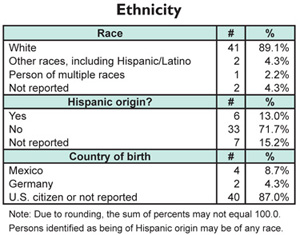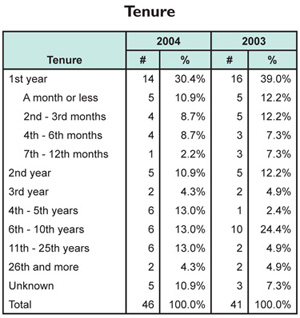
|
Oregon's Compensable Fatalities 2004 Claims included in this year's statistics are fatalities that occurred during or before 2004, and were reported to the Department of Consumer & Business Services by Jan. 31, 2005. Claims with dates of death in prior years are included if the insurer accepted and reported them for the first time within the 13-month time frame (Jan. 1, 2004-Jan. 31, 2005). Data exclude deaths of workers not subject to Oregon Workers' Compensation coverage, such as workers who were self-employed, working in Oregon for out-of-state employers, city of Portland police and fire employees, or federal employees. The compensable fatality count can be affected by tragic accidents that kill multiple victims simultaneously. During 2004 there were no incidents with multiple victims, compared with three accidents in 2003 that claimed multiple victims. In 2004 there were five cases of occupational illnesses, including asbestosis, silicosis, and cancers; this compares with one compensable occupational illness case in 2003. |
 |
 |
Industry Within the agriculture, forestry, fishing, and hunting industry group, the logging industry claimed eight compensable fatalities in 2004, 17.4 percent of the total. Eight logging fatalities were also reported in 2003. The fatal rate for logging was 102.56 workers killed per 100,000 employed in 2004, compared with 105.26 in 2003. |
|
Event or Exposure At least four of the 13 workers killed in highway motor vehicle accidents were not wearing seatbelts (four were unknown). Four of the 13 fatalities occurred on the interstate, four occurred on a highway, three occurred on a local road, and two had unknown locations. There were 17 transportation and material moving occupation employees (including truck drivers) killed in 2004 compared with six in 2003. |
 |
 |
Occupation Fourteen workers died within the first year of working for the employer in 2004. Of these 14 workers, 11 were injured in transportation accidents including motor vehicle accidents, aircraft accidents, and industrial accidents. |
| Ethnicity In 2004, Oregon began collecting ethnicity data for compensable fatalities in response to a national news story that stated that Hispanic workers were more likely to die on the job than non-Hispanic workers (see: http://www.bls.gov/iif/peoplebox.htm#faqa). |
 |
 |
Tenure Tenure is the amount of time the victim had worked for the employer and is not necessarily indicative of the level of experience. However, the tenure information does indicate the need for training and supervision of new employees. The deaths of workers with longer tenure point out the need for programs to reinforce safety training. |
|
Other interesting findings,
|
 |
Fatality/claims data
Additional information about work-related fatalities, injuries, and illnesses can be found on IMD's Web site at: http://www.cbs.state.or.us/imd/. From
the home page, select "Statistical Reports" and on the next Web page select "Workers' Compensation." From there you can find tables, descriptions of cases, and summary reports
for occupational fatalities by selecting "Fatality." Or, you may select "Claim" and "Characteristics" to find rates, tables, and summary reports for all accepted disabling
Workers' Compensation injury and illness claims.
Census of fatal occupational injuries
National work-related fatality data can be found on the Bureau of Labor Statistics' Web site at: http://www.bls.gov/iif/oshcfoi1.htm
Fatality assessment and control evaluation
Information about Oregon Health Sciences University's Fatality Assessment and Control Evaluation Program (FACE) can be found at: http://www.ohsu.edu/croet/face/
Employer workers' compensation coverage
For additional information about employer coverage requirements, you may contact the Workers' Compensation Division Employer Compliance Program at wcd.employerinfo@state.or.us,
call (888) 877-5670, or find it on the Internet at: http://www.cbs.state.or.us/external/wcd/index.html
Classification systems
Data are classified according to the following classification systems:
- Occupational Injury and Illness Classification System (OIICS)
- Standard Occupation Classification System (SOC)
- North American Industry Classification System (NAICS)
Click here to see the printable version of this brochure.
If you have questions about the information contained in this document, please contact by e-mail or phone: Tasha Hodges, (503) 947-7991, research analyst, Research & Analysis Section, Information Management Division
In compliance with the Americans with Disabilities Act (ADA), all IMD publications are available in alternative formats by calling (503) 378-4100 (V/TTY). The information in IMD publications is in the public domain and may be reprinted without permission.
This document was originally published in May 2006
[Printed form 440-0947 (5/06/COM)]